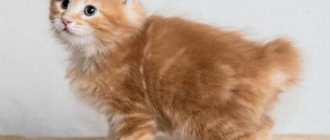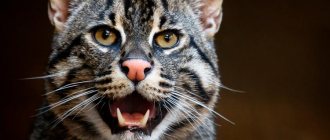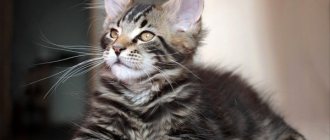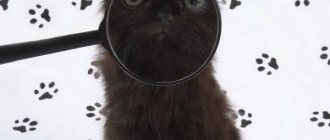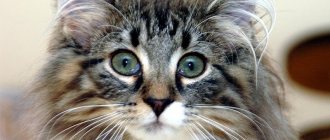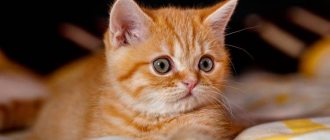Origin story
The first acquaintance with curls took place in the 60s of the 20th century, when Californian and Oklahoma farmers began to meet small cats with curled ears near their plots.
However, the matter did not go beyond banal discussions until... Until a married couple in Lakewood (California) took an emaciated, pitch-black kitten from the street and brought it into their home. The baby was named Shulamith. The grown-up cat started an “affair” with a neighbor’s outbred cat and gave birth to offspring. Almost all kittens from the litter inherited their mother's ears with a crease. Shulamith's owners, Grace and Joe Ruga, consulted a geneticist in 1983 about their unusual ears.
And then it turned out that this is the result of a genetic mutation, and the gene itself is dominant, which means that Shulamith can mate with cats of absolutely any breed: her children will still have not the father’s, but the mother’s ear shape.
The first exhibition was a triumph. In 1987, the breed was officially recognized, but there was a problem: preference was given to cats with half-length fur. Shorthairs remained behind the scenes until 1991, when TICA decided that these haircuts also have the right to development.
The first representatives were brought to Russia in 2000.
Breeders still give preference to individuals with semi-long hair. It is believed that such cats look better in photographs and generally look more glamorous.
Price
The American Curl is one of the ten most expensive cats. At international auctions, the starting price for the American Curl breed is $1,000 and does not end at $2,000. Domestic breeders offer show-class kittens of this breed much cheaper.
To purchase a healthy, purebred kitten, the best solution is to contact an American Curl nursery . There are many of them in our country. In addition, there are reputable, experienced breeders. Nurseries and breeders rarely publish their price directly.
Standards
| Standard | Description |
| Torso | The physique of Curl cats is harmonious: they do not give the impression of being thin, but they also do not gain excess weight. The body is slightly elongated, but graceful and muscular. Males weigh 5-7 kg, females rarely reach 5. |
| Head | Wedge-shaped, with smooth lines and soft curves. The chin is clearly defined, strong, the nose is of medium length, with a wide bridge. The bite is scissor-shaped. |
| Eyes | Almond-shaped, large, open. The color can be any. Exception: color point color (the iris must be bright blue). |
| Limbs | Medium length, straight, even. The paws are round and look like furry balls. |
| Tail | Equal in length to the body. Fleshy at the base, noticeably thinner and sharper towards the tip. |
| Wool | The coat is light and airy. More volume in the tail and neck area. There is almost no undercoat. |
Curls' ears acquire a bizarre curvature at 3-10 days of life. If you touch a cat’s ear, you will understand that it also feels different to the touch than the standard ear you are accustomed to: the cartilage of Curls is much harder. The inversion of the cartilage should be no more than 180 and no less than 90 degrees. Based on the curl, the breeder determines which group the kitten belongs to: a steep, pronounced curl is a show animal, a well-defined curl is for breeding, a small curl is for sale to the home.
A serious defect is considered to be a large bend in the ear cartilage: when the ear touches the skull. Also, animals with thick and wide ears, bizarrely inverted (deformed) cartilage, or a broken tail are not allowed to participate in exhibitions. Also not allowed is an obvious “stop” on the nose, or an overly soft or coarse undercoat.
Choosing a kitten
Since the breed is rare in its homeland in the USA, American Curls can only be purchased in Russia from breeders in special nurseries, of which there are no more than ten throughout the country.
When choosing a kitten, you need to check the availability and authenticity of documents, “get to know” the parents, and observe the future pet in the nursery.
It is necessary to pay attention to the conditions of detention and how actively he plays with other kittens, whether he is too aggressive or timid.
The price of a kitten will depend on the purpose for which it is purchased.
Experts have defined three standards for those wishing to purchase a kitten with curlicue ears:
- The first is a partner cat or pet. In this case, due to the weak expression of the curl, it will not be possible to exhibit the animal in professional competitions. But at home a real loving creature will appear, who is completely attached to the owner.
- The second one is bridling. This variety is suitable for breeding, but may have slight flaws that do not violate the requirements for the exterior.
- The third is the show. American Curls of the show class can produce excellent offspring and also participate in the most prestigious exhibitions. Therefore, the price for them will be higher than for kittens of the first two classes.
The ideal time to take a kitten home is twelve weeks from birth. By this time, he already knows how to eat, move around and go to the litter box on his own. We remind you that the pinna of American Curls acquires its final shape by four to six months of age.
Character and behavior
The American Curl is similar to Winnie the Pooh from a children's fairy tale: just as spontaneous and sometimes awkward, but sweet, playful and very kind. Cats of this breed completely lack the arrogance and desire to roam “on their own” that is inherent in many of their brothers: they adore people, crave company and are ready to spend the day and night next to their beloved owner.
Curls are alien to obsession: they will come running at your first call and come to wake you up with the first rays of the sun, but they will not restlessly crawl into your arm or meow mournfully in your ear, demanding entertainment. The sensitive Curl understands perfectly well when it is possible to climb onto your lap, and when it is better to hold off and stay away.
This breed absolutely does not tolerate loneliness, it grieves in separation so much that neither delicious food nor an abundance of toys can distract it from sad thoughts. Think ahead: can you give your clawed friend the right amount of attention? If your job requires frequent travel, daily deadlines, and long hours away from home, choose a cat of a different breed.
The American Curl is an attentive and fast hunter, a real threat to all small rodents and annoying insects. Therefore, such a cat and, for example, a tame rat, will not get along in the same territory. But the Curl will perfectly find a common language with other cats and even dogs and, if it does not make friends, it will not provoke any clashes or conflicts.
What does this pose mean in cats: crouching to the ground, arching their back, starting a mournful song?
Mating gamesPreparing for a fight
Adapts quickly to new surroundings and tolerates moving easily. He is not afraid of the bustle of the station, the noise of the plane and long journeys by car, the main thing is that his loved ones are nearby.
He does not shy away from guests, on the contrary, he tries in every possible way to greet them. He takes noisy companies with a bang and strives to get into the thick of the crowd. Easy to train: a curl can be trained to suit you and even learn some tricks and commands.
But remember that a cat remains a cat in any situation. Your tone should always be soft and affectionate. No swearing or swinging a slipper! Even such purrs as curls have a sense of self-esteem, which means that they can easily be offended by an orderly tone. Young animals grasp information on the fly, but it is much more difficult to persuade adults to do a somersault for a piece of liver.
Curls love walks and active games in the fresh air, so don't forget to buy a harness. The first walk can be taken no earlier than 3 months (the animal must be wormed and vaccinated in advance).
And remember: this breed has a real sense of adventure. Climbing into the drum of a washing machine (and getting stuck there), falling off a balcony, getting your head stuck in a jar, biting wires and getting an electric shock, knocking over a trash can, knocking all the flower pots off the windowsill - the list goes on and on. The owner will have to hide in advance everything that is prickly, cutting and anything that can fall and break.
You can buy a cat of the American Curl breed not only in the USA, where breeding is on a grand scale, but also in Russia, in St. Petersburg. Kittens are separated from their mother at the age of 4 months. A baby for home (without documents) costs 3-10 thousand rubles, for mating - 10-20 thousand, a cat for exhibitions - 25,000 rubles and more.
In the photo there is a cat of the American Curl breed: shorthair and longhair
Estimation of breed characteristics
| Adaptability: |
| Shedding level: |
| Social need: |
| Grooming: |
| Ease of care: |
| Attachment to family: |
| Hair loss/shedding: |
| Health/susceptibility to disease: |
A beautiful cat with unusual curled round ears is the American Curl. It appeared relatively recently, but it is gaining popularity among amateurs and professional breeders at a rapid pace. These gentle American representatives of the cat family are distinguished by their exceptionally pleasant character and unique appearance.
Care instructions
Curls need all the same things as other cats: two comfortable bowls (one for food, one for water), an open bed (or house), a suitable-sized carrier, and a tray. It wouldn’t hurt to have a cat complex where the animal can “let off steam”: jump up the steps, hang upside down, climb up and down. This design is not cheap, but it will save both your nerves and your environment. Regarding care, everything is quite simple.
Wool
Curls' hair does not tangle or mat, so all you need to do is buy a brush with natural bristles and a fine-tooth comb. You should comb your cat 1-2 times a week: first with a comb and then with a slicker brush.
Bathing
Curls have nothing against bathing, but you shouldn’t give them bath days too often. 2-3 times a year is quite enough, and also when necessary: if the curl is dirty and cannot clean the skin on its own, and before the exhibition.
Choose a special shampoo from a pet store, not a human one. Otherwise, the cat will have an upset stomach. For individuals with short fur, it is enough to wipe them thoroughly with a towel, while a hairdryer will help speed up the drying of long-haired animals.
Ears
Curls' ears, the pride of their cats, require special handling because the cartilage can be broken under too much pressure. Accumulated sulfur and dirt are removed with a cotton swab dipped in clean water, a weak decoction of chamomile, or a special lotion. If you notice a dark coating in the ear, take your cat to the veterinarian. And one more thing: try not to touch the curls on his ears again - this will cause the Curl to experience discomfort.
Eyes
Cats of this breed usually do not have eyes that run, but if discharge begins to accumulate in the corners, remove it with a damp cotton pad.
Claws
But problems often arise with claws, because they grow very quickly and often grow into the soft tissue of the pads. Therefore, in addition to the scratching post, you should buy nail clippers and trim the claws once a week.
Teeth
Teeth are brushed every week - this will protect the animal from tartar, gingivitis and other unpleasant diseases of the oral cavity. Ideally, you should buy a special toothbrush and toothpaste. Both are sold in pet stores.
Brushes can be made of silicone, which are placed on the fingers, and regular ones, which look similar to human ones, but are small in size. The choice of toothpastes is several times larger: gel-like and in the form of drops, with the taste of meat, fish or mint.
Human toothpaste is not suitable for cats: not only does it not prevent inflammation and tartar, but it is also toxic.
If the pet categorically does not want to participate in this, you will have to take him for ultrasound cleaning to the veterinary clinic, where all the necessary procedures will be carried out under general anesthesia.
As preventive measures, you can use special drops (they are dripped into drinking water), edible pads, toys and sticks with catnip, and specially designed dry food.
In the photo there is a cat of the American Curl breed, not happy with something)
Health
No genetic diseases have been recorded in American Curls. Like any sedentary cat, they can suffer from obesity, which has a negative impact on their cardiovascular health.
Also, an American Curl cat or cat may suffer from:
- allergic diseases;
- dental diseases;
- inflammation of the genitourinary tract;
- worms.
These are minor illnesses that can be prevented with annual veterinary examinations and regular vaccinations.
There are no special vaccinations for Curls. Vaccination is carried out according to the standard scheme, and the pet tolerates it well.
Important! Before vaccination, you need to limit your cat's contact with other animals. The vaccine is administered only to a healthy cat, with normal body temperature and without diseases.
Catering
Curls love to eat, and they are not particularly picky: they will not disdain to get into a trash can, and they will try to steal a piece of wrapped meat from a bag. And this is fraught with serious stomach problems. When choosing a nutrition system - whether a natural menu or ready-made food - remember that the food must be balanced, the products must be fresh, and the portions must be appropriate to the physical condition and age of the animal.
Babies eat at least 6 times a day, teenagers (at 4-5 months) - 4 times, over six months - 3 times, from one and a half years - 2 times: in the morning and in the evening. Bowls are washed after every meal. The water is also changed 2 times a day.
Natural products
- The basis of the Curl diet is meat (veal, rabbit, beef, turkey) and offal (stomachs, hearts, liver). The meat is not boiled, but defrosted and doused with boiling water. Offal can be stewed or served raw.
- 4-5 times a week cats are fed porridge cooked in water: rice, oatmeal, millet, buckwheat. Liquid semolina porridge with milk can be given to babies.
- Add boiled chicken egg white to the porridge 1-2 times a week. Quails are crushed whole.
- Vegetables (carrots, zucchini, pumpkin, cabbage, beets, green beans) are stewed, but if the cat wants to chew on a raw cucumber, do not forbid it. Cucumbers, like melons, are allowed.
- Almost everything can be given from dairy products: cottage cheese, sour cream, cream, kefir, natural yogurt, Varenets, yogurt, unsalted cheese. Choose products without dyes, flavor enhancers and other harmful additives.
What is it forbidden to give to Curls?
- Fatty meat: pork, lamb, goose and duck. It takes a long time to digest, and in addition, it is often contaminated.
- Fish (both sea and river).
- Whole cow's milk (if the Curl has not been accustomed to it since childhood).
- Tea, coffee, cocoa, juices and sparkling water, alcohol.
- Smoked, flour, sweet, salty, sour.
- Citrus fruits, avocados, eggplants, tomatoes, potatoes, legumes (chickpeas, peas).
- Dog food, human canned food, sausages, sausages, tripe.
- Bones, lard.
Recommended food
When giving preference to industrial feed, choose either super-premium or holistic feed.
- Holistic: Naturea, Now Fresh, Wellness CORE.
- Super premium: Husse, Ontario, Matisse, Meglium.
Below are recommended super-premium foods. Links with the names of the food are clickable, on them you can, within our website, get acquainted with the descriptions of the food and read reviews from owners of American Curl cats.
| Holistic | Super premium | Super premium |
| Savarra | Mera Finest Fit | Happy Cat |
To cleanse their stomach, wild cats eat a certain kind of grass that they find in the meadows. For pets, you can grow wheat or oats at home.
Pictured are kittens of the American Curl breed.
Adaptation to a new home
These pets, like Abyssinian cats, are simply created for communication. Surprisingly, they are absolutely not afraid of strangers or house guests. On the contrary, they will show great interest in every visitor. This is a cat that is incredibly kind to its owner and is ready to follow him everywhere. She is like a real faithful dog, devoted and attentive.
It is important to note that there is no intrusiveness in this. These fidgets simply love to take an active part in household chores: from watching TV with their owner to doing laundry or general cleaning. They will never allow themselves to be annoying; it is not in their proud nature. Many owners of this wonderful breed note that Curls love to bring them a newspaper after a hard day at work or during breakfast.
Curls adore children, which is facilitated by their enviable energy and desire to discover something new. At the same time, they are particularly calm. They are also fans of noisy parties and all kinds of holidays because among a large number of guests they can show various tricks and performances. That is why individuals of this breed are called nothing more than clowns.
They have an increased need for socialization. They can get along with cats of all breeds with great ease. Surprisingly, their wonderful character knows no bounds: they are even able to find a common language with dogs. They develop a real friendship. They have fun together playing racing.
This is a very significant plus, which makes it possible not to worry about the cat while the owners are away from home all day. During this time, the cat will communicate and play with the rest of the pets living in the house.
Diseases
The American Curl is a healthy breed, and no genetic pathologies were recorded in any individual. But improper care can provoke many diseases.
- Obesity.
- Diabetes.
- Allergy.
- Oral diseases.
- Urolithiasis (pyelonephritis, chronic renal failure).
- Worms.
- Myocarditis, myocardosis.
- Ear mites.
Be sure to give your cat all the necessary vaccinations, even if you do not let him out for walks. Calcivirosis, feline distemper, ringworm - the causative agents of all these ailments can be easily brought home by you yourself: on the soles of shoes, the edge of a jacket or on your hands. Treatment will be expensive, long and without guarantees of recovery. And rabies, which is transmitted through a bite, cannot be cured at all.
Expert opinion
Dusheba Vera Ivanovna
In 2010, she graduated from the Moscow State Academy of Veterinary Medicine named after K.I. Scriabin with honors, specializing in veterinary medicine. I regularly attend veterinary conferences, congresses, and webinars.
Curls can be mixed with cats of other breeds similar in standard. In this case, kittens are almost always born without serious deviations, but there will be noticeably fewer individuals with curls in the litter if two Curls were brought together.
How much does an American Curl cost?
The price for pet class Curls (pets subject to sterilization) starts at 3,000 rubles. There are individuals whose cost can exceed 60,000 rubles. Individuals that perfectly meet all the requirements of breed standards are rarely born. Usually all individuals have some minor deviations and defects.
How to choose and name a kitten
You should only choose a kitten from trusted breeders with a good reputation. The animal must have documents with a pedigree, which indicates the names and details of the parents. Without a pedigree, no matter how beautiful a pet is, it cannot be called purebred. Only official documents indicate which club the animal belongs to, the data of the parents and their ancestors. These records include names, breeds, titles.
After purchasing a baby, the owners are puzzled by choosing a name. It is better to take a closer look at the kitten and find something that makes it stand out in appearance and character. Then the nickname will be truly individual, unique only to him. But if no ideas arise, it doesn’t matter. You can always use the table of popular names for cats and find a nickname to your liking:
Popular nicknames for cats.
